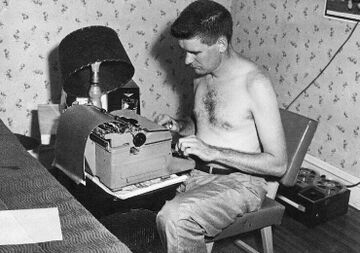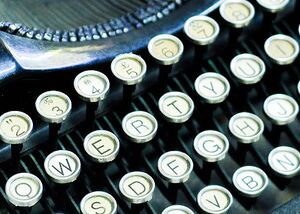Difference between revisions of "Typer"
| (7 intermediate revisions by 2 users not shown) | |||
| Line 1: | Line 1: | ||
| − | (Did you mean a [[ | + | ''(Did you mean a [[Typers (Neale)|Andrew C. Neale fanzine]]?)'' |
| − | The '''typer''', short for '''''typewriter''''' (or | + | [[File:TuckerTyper.jpeg |thumb|right|upright=1.2|'''[[Bob Tucker]] at the typer in his [[den|fan den]] in the mid-1950s.''' ''Photo by [[Bob Madle]].'']] |
| + | The '''typer''', short for '''''typewriter''''' (or '''''tripewriter'''''), was a fascinating kind of ''entirely mechanical'' [[wordprocessor]] used widely in [[fandom]] until the 1990s. | ||
| − | The archaic device was used by legendary olden-time [[fen]] | + | The archaic device was used by legendary olden-time [[fen]] for writing everything from letters to [[fanzines]]. Today's computer users would recognize the basic primitive keyboard as being the same [[QWERTYUIOP]] configuration as that used on a computer, except the typer's lacked function keys, numbered key pad, most alternate purpose keys and programming functions, and the only purpose of the "shift" key was to change from lower to upper case. (The "upper case" numbers are symbols, pretty much just as they are on a proper modern keyboard.) |
Typer keys were hit with sufficient force to cause them to strike a moving [[ribbon]] (sometimes of [[carbon paper]], sometimes of ink-impressed cloth) which in turn hit the paper and left its impression on the page, making revision difficult. But the advantage of typers was that they were excellent mates to the primitive [[mimeographs]] and [[spirit duplicators]], in that the ribbon could be removed or disengaged so the keys struck a [[mimeograph stencil]] (it could be left on to strike a [[Ditto master]]) with sufficient force to make the kind of impression needed to cause the stencil or master to work properly. | Typer keys were hit with sufficient force to cause them to strike a moving [[ribbon]] (sometimes of [[carbon paper]], sometimes of ink-impressed cloth) which in turn hit the paper and left its impression on the page, making revision difficult. But the advantage of typers was that they were excellent mates to the primitive [[mimeographs]] and [[spirit duplicators]], in that the ribbon could be removed or disengaged so the keys struck a [[mimeograph stencil]] (it could be left on to strike a [[Ditto master]]) with sufficient force to make the kind of impression needed to cause the stencil or master to work properly. | ||
| − | Some of the very earliest typers were not even electrically powered but rather were operated solely by means of manual force. It is possible, however, that this may be one of those "fanciful tales" which old-time | + | [[File:Typer.jpeg|thumb|left|'''Early typer keys'''. ]] |
| + | Some of the very earliest typers were not even electrically powered but rather were operated solely by means of manual force. It is possible, however, that this may be one of those "fanciful tales" which old-time fans are reportedly prone to tell [[neofan|neos]] to make them feel inferior. | ||
| − | + | In theory, ''typer'' could apply to whatever sort of keyboard you type on, but the term did not follow fans to word processors, let alone computers. | |
| − | + | * [https://www.officemuseum.com/typewriters.htm Typewriters at the Early Office Museum.] | |
{{fancy2|text= | {{fancy2|text= | ||
| − | [[Fans]] have ''machins à écrire'' of all vintages, even some of the antiquated strike-underneath kind. The lack of the letter F on [[Perdue]]'s typewriter gave him his first fame; one time [[Jack Gillespie]] of the [[Futurians]] [[stencilled]] a tirade against [[Moskowitz]] on a machine whose z was missing | + | '''Typer''' [[Fans]] have ''machins à écrire'' of all vintages, even some of the antiquated strike-underneath kind. The lack of the letter F on [[Perdue]]'s typewriter gave him his first fame; one time [[Jack Gillespie]] of the [[Futurians]] [[stencilled]] a tirade against [[Moskowitz]] on a machine whose z was missing. |
| − | |||
| − | |||
| + | Blue-and-red and sometimes odd combinations like [[neotric]] green-and-brown [[typeribbons]] are employed by many fans. The most favored type is elite, like this before you, but some fans have the slightly larger pica. Variants include elite with pica spacing, Vogue (similar to gothic), script, and a Royal face with small serifs tagged deputy serif. In addition, [[4E|Ackerman]], [[H. C. Koenig|König]], [[Dick Ellington|Ellington]], [[John Magnus|Magnus]] and others have had access to Varitypers, which operate on an awkward principle of moving a block of letters back and forth and striking the paper against the letters, which permits the use of interchangeable plates carrying all sorts of alphabets. In size they've varied from gigantic to teenchy (you figure out the point number!) and in style have had italic, gothic, boldface, and others besides normal type. | ||
}} | }} | ||
{{fancy1|text= | {{fancy1|text= | ||
'''Typewriter''' | '''Typewriter''' | ||
| − | U mean [[ | + | U mean tripewriters? |
| + | }} | ||
| + | |||
| + | {{fancy1|text= | ||
| + | '''Tripewriters''' ([[William H. Groveman|Groveman]]) - [[Fans]] have machine ''á ecrire'' of all vintages, possibly even some of the strike-underneath kind. Preference runs to L C Smith & Corona, and Underwood, but we take whatever we can get. The lack of the letter F on [[Elmer Perdue|Perdue]]'s typewriter gave him his first fame; one time [[Jack Gillespie|Gillespie]] [[stenciled]] a tirade against [[Sam Moskowitz|Moskowitz]] on a machine whose z was missing. | ||
| + | |||
| + | Blue-and-red and [[neotric]] green-and-brown typeribbons are employed by many [[fans]]. The most favored type face is elite, like this before you, but some [[fans]] have the somewhat larger pica. Variants include elite with pica spacing, vogue (similar to gothic), and a face like heavy oldfashioned printing. In addition, [[4E|Ackerman]] and [[H. C. Koenig|König]] have had access to varitypers, which operate on an antediluvian principle which permits the use of plates carrying all sorts of alfabets. In size they've varied from gigantic to teensy (you figure out the point number!), and in style have had italics, gothic, boldface, ''et autres''. | ||
}} | }} | ||
| − | {{ | + | |
| + | {{fanspeak}} | ||
[[Category:fancy1]] | [[Category:fancy1]] | ||
[[Category:fancy2]] | [[Category:fancy2]] | ||
| − | [[Category: | + | [[Category:publishing]] |
[[Category:obsolete]] | [[Category:obsolete]] | ||
Latest revision as of 18:55, 21 July 2023
(Did you mean a Andrew C. Neale fanzine?)
The typer, short for typewriter (or tripewriter), was a fascinating kind of entirely mechanical wordprocessor used widely in fandom until the 1990s.
The archaic device was used by legendary olden-time fen for writing everything from letters to fanzines. Today's computer users would recognize the basic primitive keyboard as being the same QWERTYUIOP configuration as that used on a computer, except the typer's lacked function keys, numbered key pad, most alternate purpose keys and programming functions, and the only purpose of the "shift" key was to change from lower to upper case. (The "upper case" numbers are symbols, pretty much just as they are on a proper modern keyboard.)
Typer keys were hit with sufficient force to cause them to strike a moving ribbon (sometimes of carbon paper, sometimes of ink-impressed cloth) which in turn hit the paper and left its impression on the page, making revision difficult. But the advantage of typers was that they were excellent mates to the primitive mimeographs and spirit duplicators, in that the ribbon could be removed or disengaged so the keys struck a mimeograph stencil (it could be left on to strike a Ditto master) with sufficient force to make the kind of impression needed to cause the stencil or master to work properly.
Some of the very earliest typers were not even electrically powered but rather were operated solely by means of manual force. It is possible, however, that this may be one of those "fanciful tales" which old-time fans are reportedly prone to tell neos to make them feel inferior.
In theory, typer could apply to whatever sort of keyboard you type on, but the term did not follow fans to word processors, let alone computers.
| From Fancyclopedia 2, ca. 1959 |
| Typer Fans have machins à écrire of all vintages, even some of the antiquated strike-underneath kind. The lack of the letter F on Perdue's typewriter gave him his first fame; one time Jack Gillespie of the Futurians stencilled a tirade against Moskowitz on a machine whose z was missing.
Blue-and-red and sometimes odd combinations like neotric green-and-brown typeribbons are employed by many fans. The most favored type is elite, like this before you, but some fans have the slightly larger pica. Variants include elite with pica spacing, Vogue (similar to gothic), script, and a Royal face with small serifs tagged deputy serif. In addition, Ackerman, König, Ellington, Magnus and others have had access to Varitypers, which operate on an awkward principle of moving a block of letters back and forth and striking the paper against the letters, which permits the use of interchangeable plates carrying all sorts of alphabets. In size they've varied from gigantic to teenchy (you figure out the point number!) and in style have had italic, gothic, boldface, and others besides normal type. |
| From Fancyclopedia 1, ca. 1944 |
| Typewriter
U mean tripewriters? |
| From Fancyclopedia 1, ca. 1944 |
| Tripewriters (Groveman) - Fans have machine á ecrire of all vintages, possibly even some of the strike-underneath kind. Preference runs to L C Smith & Corona, and Underwood, but we take whatever we can get. The lack of the letter F on Perdue's typewriter gave him his first fame; one time Gillespie stenciled a tirade against Moskowitz on a machine whose z was missing.
Blue-and-red and neotric green-and-brown typeribbons are employed by many fans. The most favored type face is elite, like this before you, but some fans have the somewhat larger pica. Variants include elite with pica spacing, vogue (similar to gothic), and a face like heavy oldfashioned printing. In addition, Ackerman and König have had access to varitypers, which operate on an antediluvian principle which permits the use of plates carrying all sorts of alfabets. In size they've varied from gigantic to teensy (you figure out the point number!), and in style have had italics, gothic, boldface, et autres. |
| Fanspeak |
| This is a fanspeak page. Please extend it by adding information about when and by whom it was coined, whether it’s still in use, etc. |

